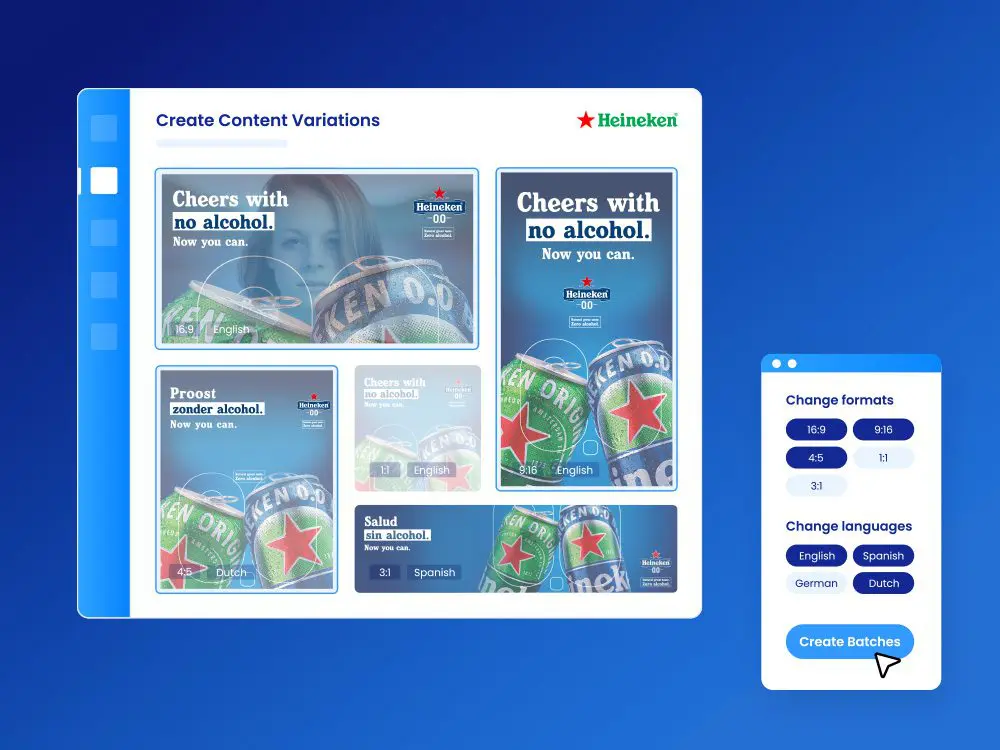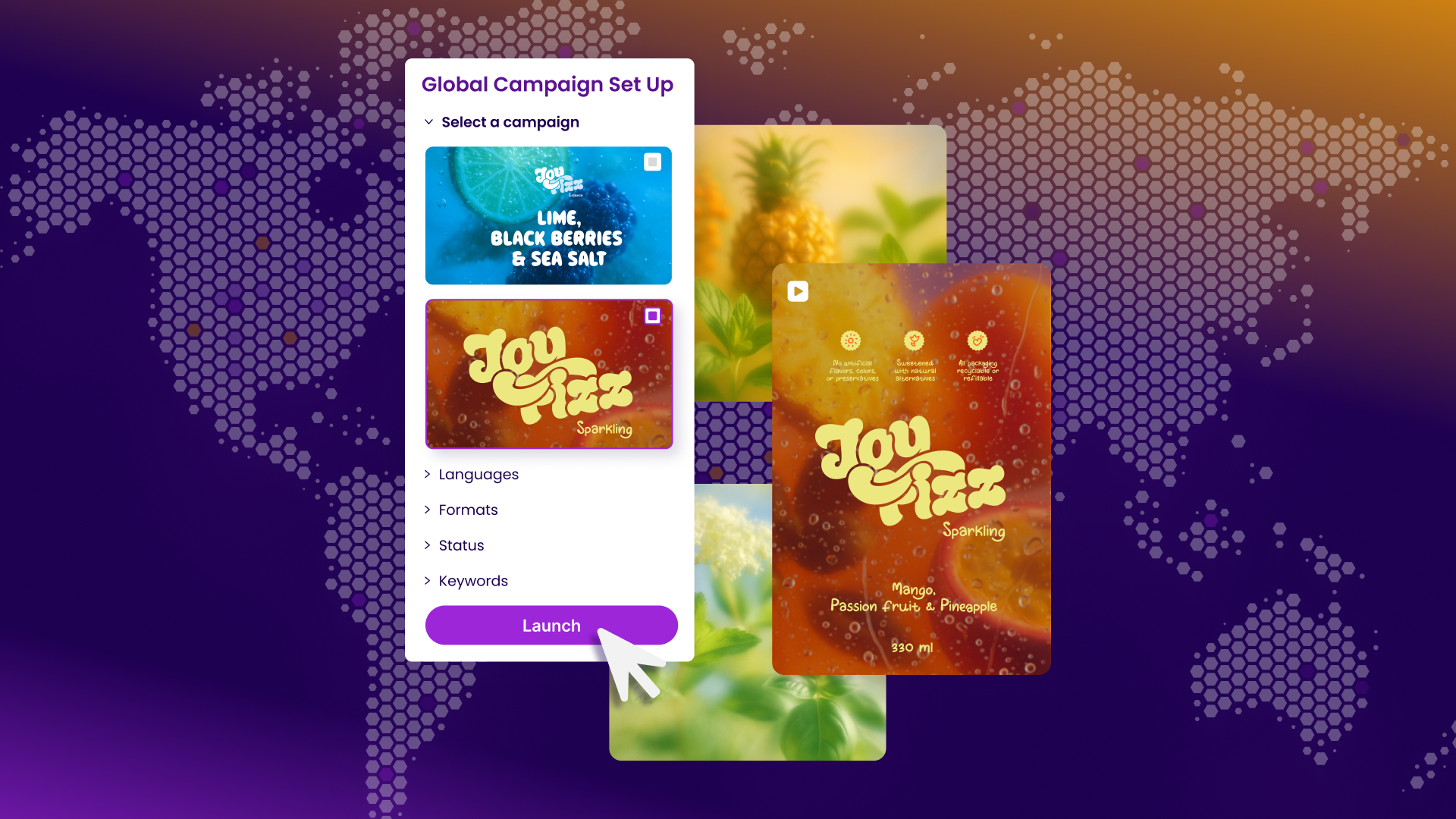Luckily Creative Automation, which refers to reducing the amount of manual labour involved in the creative design processes, offers a solution. With it, design teams can easily work from templates designed by the global team, making sure that they can localise content fast and fully in line with brand guidelines.
In this blog, we’ll first dive into the complications of localising content on a global scale. Then, we explain the role that Creative Automation can play in simplifying that process. Finally, we’ll share some strategies to master your content localisation. Let’s get started.
What makes content localisation so challenging?
According to Friedman International, reaching local customers is one of the biggest challenges faced by global marketers. Their main reason? There is simply no “one-size-fits-all” approach for marketing campaigns. Adapting an idea to local markets takes more than just translating. Emotional elements, digital understanding and maturity in the market also play a role. But there are more challenges:
- Resource & budget constraints
- Duplicated efforts
- Brand & quality control
- Time zones & real-time marketing
Resource & budget constraints
Many organisations struggle with limited resources and budgets, especially at the local level. Local marketing teams often face constraints in terms of available workforce, time, and financial resources. Consequently, they must seek cost-effective strategies for customising and localising global marketing content. Otherwise, local teams may divert their budgets towards other seemingly more compelling initiatives, potentially favouring investments in “exciting” endeavours over translation efforts.
Duplicated efforts
One of the common pitfalls in global marketing is the duplication of efforts. In the absence of a streamlined and automated process, different local teams often end up creating similar content independently. This duplication not only wastes time and resources but can also lead to inconsistencies in messaging and design.

Brand & quality control
Maintaining brand consistency and quality across various local markets can be a formidable challenge. Without a unified system in place, local marketing teams may inadvertently deviate from brand guidelines and produce content that doesn’t align with the brand’s identity.
Time zones & real-time marketing
Operating across different time zones poses another layer of complexity. Launching real-time marketing campaigns and promotions that coincide with local events, festivals, or public holidays requires precise timing. Failing to do so can result in missed opportunities and diminished campaign effectiveness.
To overcome these challenges, Creative Automation is a key consideration.
What is the role of Creative Automation in global marketing?
Creative Automation revolutionises how marketers approach their strategies by streamlining various crucial aspects of marketing, from content creation to distribution. At its core, Creative Automation leverages data-driven insights and smart technologies to enable marketers to create, customise, and deploy marketing materials rapidly and effectively.
Creative Automation, for example, helps marketers to reduce their creative turnaround time, improve their Return-On-Ad-Spend, but also eases up their content localisation. It does so in the following ways: Speed, consistency and customisation.
Creative Automation increases speed
No more struggling with manual translations or endless correction rounds with HQ. Creative Automation ensures that marketers can eliminate unnecessary manual work, rapidly localise content, and cut out time-consuming back-and-forth amends.
More consistency because of automated templates
Automated templates ensure that brand guidelines are strictly followed across local markets. This consistency prevents local marketing teams from inadvertently diverging from the global strategy.
Successful customisation in each market
Creative Automation allows for rigorous testing capabilities. It enables designers to create campaigns much faster, and therefore try out multiple versions for effectiveness. It enables marketers to tailor their strategies based on real-time data, ensuring maximum impact in diverse markets.
All in all, Creative Automation is how the world’s biggest brands produce and test their global campaigns. It ensures speed and consistency while allowing them to localise, customise and fully test their content strategies.

Strategies to master your localisation game
To streamline your localisation efforts effectively and ensure consistent results across regions, consider the following best practices:
1. Create dynamic templates for easy customisation
One of the key advantages of Creative Automation is the ability to develop dynamic templates that can be easily customised for different regions. These templates serve as the foundation for creating localised content while maintaining brand consistency.
By establishing a set of templates, you provide your local marketing teams with a flexible framework that allows them to make region-specific adjustments without the need for extensive design work. This approach ensures that content is not only on-brand but also tailored to resonate with local audiences.
2. Develop a centralised archive of pre-approved content components
A centralised archive of pre-approved content components is a must in any streamlined localisation process. This archive includes images, brand assets, translations, and other design elements that have been reviewed and approved at the global level.
By maintaining a well-organised repository of such assets, you make them easily accessible to and usable by local teams. This not only simplifies the localisation process but also guarantees that all content adheres to brand guidelines and quality standards.
3. Utilise collaboration tools
Effective communication between global and local teams is crucial for successful localisation. Make full use of the collaboration tools, for example the ones integrated into your Creative Automation platform. These tools enable seamless communication, file sharing, and feedback exchange between teams, wherever they are in the world.
By implementing these best practices, Creative Automation transforms localisation from a time-consuming and complex task into a streamlined, efficient, and consistent process that yields impressive results across diverse markets.
Conclusion
Navigating through the challenges of varied customer preferences, resource constraints, quality control, time zones and real-time opportunities has never been more crucial. Creative Automation stands as the beacon of efficiency and effectiveness, simplifying these complexities.
Through the power of speed, Creative Automation eliminates time-consuming manual work, enabling localisation at unprecedented speed. Consistency ensures brand integrity across diverse markets, preserving the core message, while adapting it to local preferences. Customisation, driven by rigorous testing, empowers marketers to tailor their strategies based on real-time data and ensure maximum impact in every corner of the world.
It’s how the world’s leading brands produce and test their global campaigns: with speed, consistency, and fully tested, customised, local strategies. By adopting the best practices of dynamic templates, centralised content components, and efficient collaboration, localisation is transformed from a daunting and lengthy challenge into a streamlined, efficient, and consistent process.
In the end, it’s not just about localisation; it’s about the global success of your brand.
Want to read more about how Creative Automation can help you?
Then have a look at how Heineken reduced their overall production costs by 40% with the help of Storyteq and Creative Automation.
Read their story here!
